Rug Placement 101: How to Choose the Perfect Size Rug for Every Room
This is your ultimate guide to mastering the art of selecting the right rug for your space. The choice of a rug, often overlooked, is crucial in defining a room's character and functionality. A well-chosen rug enhances a room's aesthetic appeal and contributes significantly to its practicality and comfort.
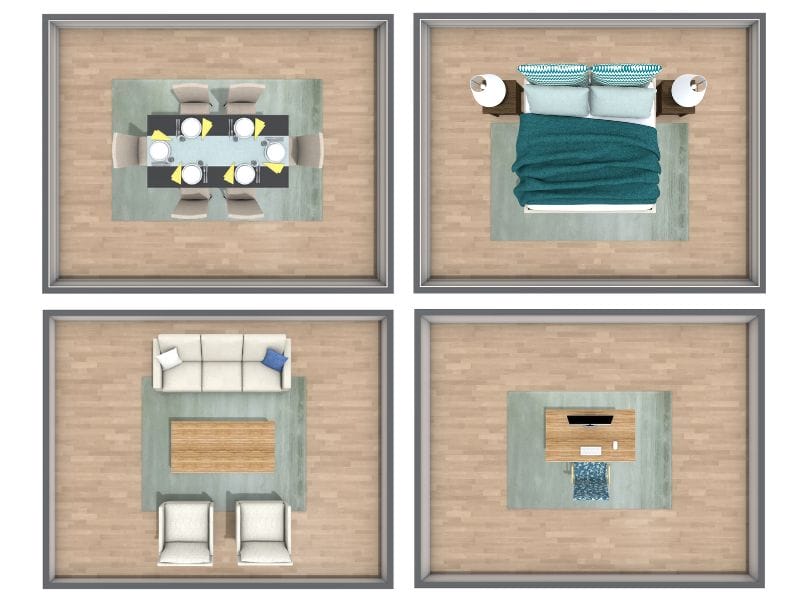
In this guide, we delve into the intricacies of rug placement, exploring how the right size and positioning can transform the ambiance of any room. From creating cozy corners in large spaces to defining functional areas in open-plan homes, we'll show you how the power of a perfectly placed rug can elevate your home's design to new heights.
Whether you're a seasoned decorator or just starting your interior design journey, these insights will help you make informed decisions that blend beauty with utility. Let's embark on this journey to find the perfect rug that complements every room in your home!
What is an Area Rug?
An area rug is a piece of carpet, distinct from wall-to-wall carpeting, used to cover a specific portion of a floor. These rugs come in various sizes, shapes, materials, and designs. They are often used as decorative elements to define spaces, add warmth and texture, and complement the interior decor of a room.
Unlike full-room carpets, area rugs are portable and can be strategically placed to enhance the aesthetic appeal and functionality of living spaces, from living rooms and bedrooms to offices and hallways.
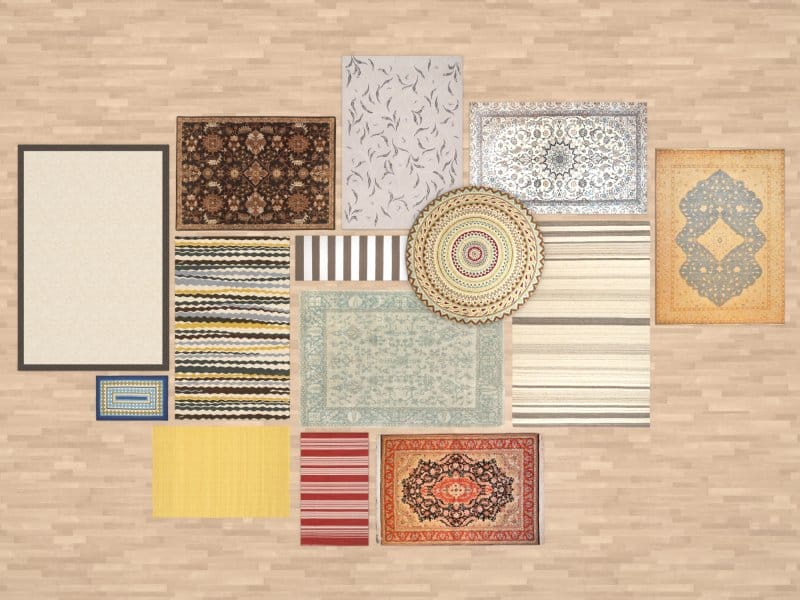
Understanding Rug Sizes and Room Dimensions
Understanding the interplay between rug sizes and room dimensions is a foundational step in achieving harmonious interior design. Rugs come in a variety of standard sizes, each suited to different spaces and furniture arrangements.
Common sizes include small rugs like 3x5 or 4x6 feet, ideal for accentuating smaller areas or nestled under coffee tables. Medium-sized rugs, typically 5x8 or 6x9 feet, are versatile choices for many living spaces, providing ample coverage without overwhelming the room. For larger areas, 8x10 or 9x12 feet rugs offer substantial ground coverage, perfect for anchoring furniture in spacious living rooms or under dining tables.
When measuring a room for the perfect rug fit, start by considering the room's layout and furniture. Measure the area you want to cover, ensuring to leave a consistent and proportional border of flooring around the rug.
This frames the rug beautifully and helps maintain a sense of balance in the room. For living rooms, a common rule is to have the front legs of sofas and chairs on the rug, creating a cohesive look. In dining rooms, ensure the rug is large enough for chairs to remain on the rug even when pulled out.
Here's a quick reference guide for room and rug size matching:
- Small Rooms (up to 10x10 feet): Opt for 4x6 or 5x8 feet rugs.
- Medium Rooms (up to 12x12 feet): Choose between 6x9 or 8x10 feet rugs.
- Large Rooms (more than 12x12 feet): 9x12 feet or larger rugs work best.
- Dining Room: Ensure the rug extends at least 24 inches beyond the table on all sides.
- Bedroom: A rug should extend around 18-24 inches on either side of the bed.
How to Place an Area Rug in a Living Room?
Rug placement in the living room can dramatically influence the room's overall feel and functionality.
The most visually appealing placement often involves having the front legs of sofas and armchairs on the rug. This creates a sense of connection among the furniture pieces, allowing the rug to define the seating area.
In a living room with a sectional sofa, ensure the rug is large enough to fit under all pieces, maintaining a balanced look. For a more open feel, you can place the rug in the center of the seating arrangement, with no furniture legs on the rug, which is particularly effective in smaller or more casual living rooms.
In all scenarios, leave enough space around the edges of the rug to reveal some flooring, which helps to avoid the feeling that the rug is floating in the room.
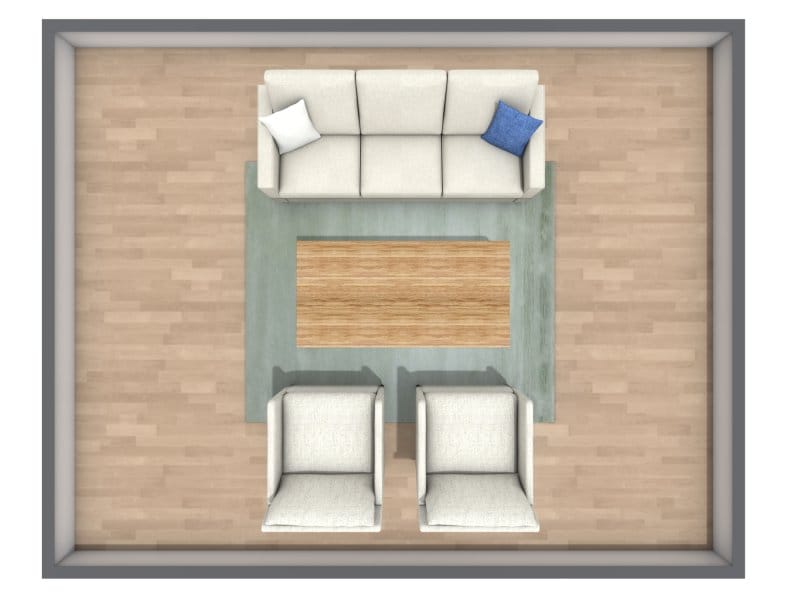
How to Place an Area Rug in a Bedroom?
Rug placement in the bedroom is an artful balance of comfort and style. For small bedrooms, a 5x7 or 6x9 feet rug is often sufficient, ideally placed at the foot of the bed or alongside it, leaving a cozy border for your feet to land on when you rise.
In a medium-sized bedroom, an 8x10-foot rug offers more coverage and can be positioned under the lower two-thirds of the bed.
For larger bedrooms, a 9x12 feet or even larger rug allows for a luxurious feel, with the rug extending around the bed, creating a plush perimeter. A key tip for rug placement under the bed is to ensure the rug extends at least 18-24 inches on all sides of the bed. This provides a soft, warm landing for your feet and adds a visually appealing frame to the bed.
If you prefer a smaller rug, consider using runners on either side of the bed or a single runner at the foot, offering comfort without overwhelming a smaller space.
The rug's positioning should also consider the room's layout and other furniture pieces. For instance, in a bedroom with a seating area, you might choose a rug that ties the bed and seating area together, creating a cohesive look. The rug's texture and material are important, too, with plush fabrics adding extra comfort underfoot in a space meant for relaxation.
The goal is to create a serene and inviting atmosphere where the rug enhances the bedroom’s ambiance and comfort.

Rug Placement in the Dining Room
Selecting the right rug for your dining room is not just about aesthetics but also functionality and comfort.
The size of the rug should complement the shape and size of your dining table, allowing for a harmonious and balanced look. For a rectangular or oval dining table, a rug that mirrors its shape, usually an 8x10 or 9x12 feet size, works well.
For round or square tables, opt for a rug that provides a proportional frame, such as a round rug for a round table or a square rug for a square table, typically in sizes ranging from 6x6 to 8x8 feet.
The importance of chair leg room on the rug cannot be overstated. It is essential that the rug extends far enough beyond the table so that the chairs remain on the rug even when they are pulled out and someone is sitting in them. This protects your floor from scratches and ensures the chairs are stable and guests comfortable.
A good rule of thumb is to allow an extra 24-30 inches from the table edge to the edge of the rug on all sides.
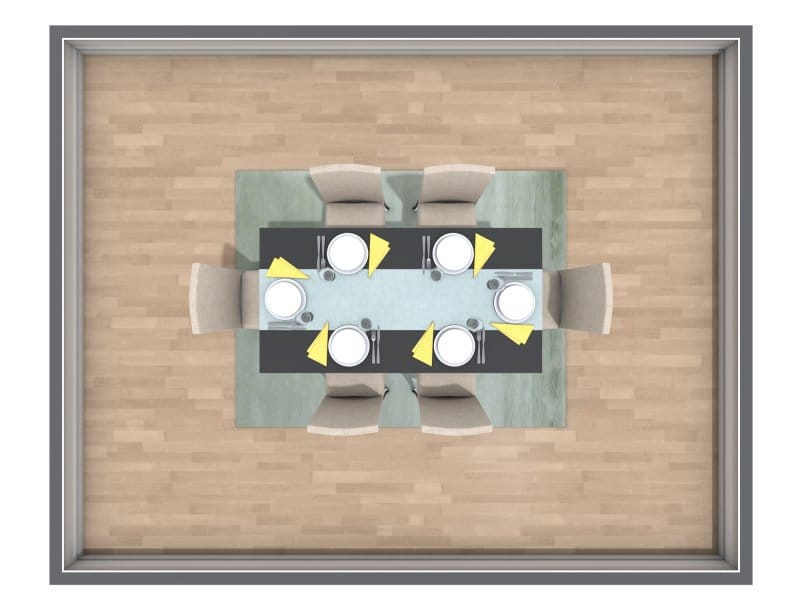
Office Rug Placement
When choosing a rug for your home office, consider the color and style of your office furniture. A rug that contrasts with the furniture can create a focal point, while a rug in harmonious colors can bring a sense of calm and cohesion to the space.
A minimalist rug with clean lines and subtle patterns works well for a sleek, modern office. A rug with rich textures or vibrant patterns can add depth and interest in a more eclectic space.
The rug's material is also important; a low-pile or flatweave rug facilitates easier movement of office chairs and is generally more durable for high-traffic areas. Ergonomics and chair movement are critical considerations in a home office. A rug that is too plush may hinder the movement of an office chair and can be ergonomically challenging. It's important to ensure that the rug provides a stable base for the chair, reducing strain on your legs and back.
A chair mat made out of thick plastic with teeth to grip the rug can be used on top of the rug under the desk area for easier movement and to protect the rug from wear.
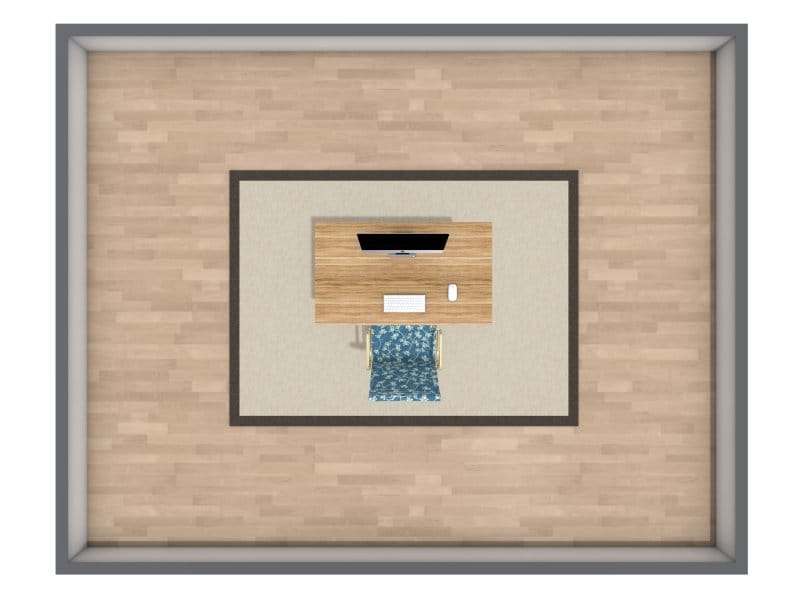
What size rug is best for under a desk?
This depends largely on the size of your desk and the layout of your office. For a standard-sized desk, a 5x7 or 6x9 feet rug is typically sufficient, allowing the desk and chair to sit comfortably on the rug with extra space for easy chair movement. For larger executive desks or L-shaped setups, an 8x10 feet rug may be more appropriate, providing ample coverage and defining the work area effectively. The key is to ensure that the rug accommodates both the desk and the chair, allowing for a comfortable and functional workspace.
Unique Spaces and Considerations
Rug placement in unconventional spaces such as hallways, kitchens, and bathrooms can add an unexpected touch of style and comfort, transforming these often overlooked areas into integral parts of your home's design.
In hallways, long, narrow runners are ideal, guiding the flow of traffic while adding color and texture. The length of the runner should be proportional to your hallway, leaving a few inches of bare floor on either end to frame the space.
Consider placing small rugs or runners in high-traffic areas in the kitchen, like in front of the sink or stove. These rugs should be durable, easy to clean, and provide comfort underfoot during those long hours of cooking and cleaning.
Small, plush rugs in bathrooms can create a spa-like atmosphere, offering a soft landing after a bath or shower. Choose moisture-resistant materials that can withstand the damp environment. The rug should be proportionate to the bathroom size, possibly placed in the center of a large bathroom or beside the bathtub in smaller spaces.
Layering rugs is a fantastic way to add depth and interest to any room. When layering, mix textures and patterns for a dynamic look. Place a larger, neutral rug as a base and layer a smaller, more vibrant rug on top. This technique works well in living rooms and bedrooms, where you might layer a patterned rug over a larger jute or sisal rug. Runners can also be layered over larger rugs in living rooms or used in pairs in wider hallways for a symmetrical effect.
Remember, the key to successful rug layering is to keep a cohesive color scheme and varying textures to maintain visual interest without overwhelming the space.
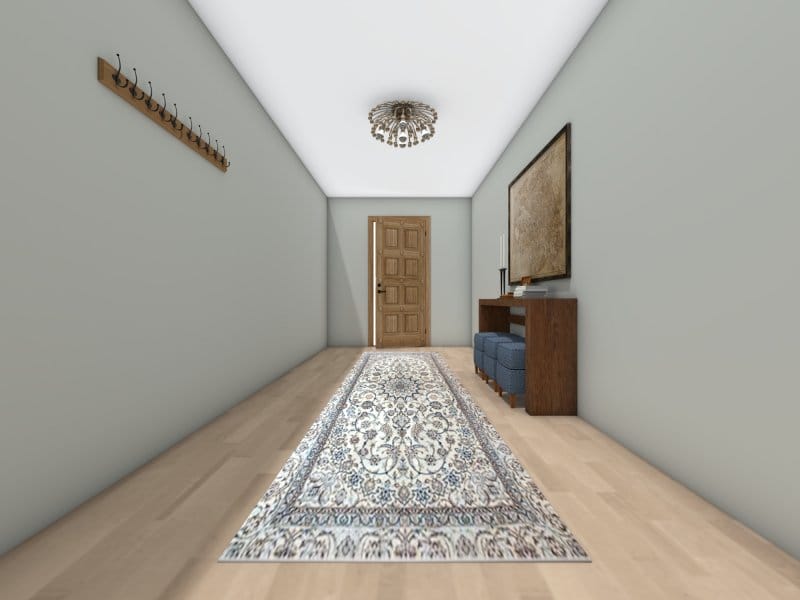
Rug Maintenance and Care
Maintaining the beauty and longevity of your rugs requires understanding the specific care needs of different types of rugs.
Natural fiber rugs, such as wool or cotton, often require regular vacuuming to remove dirt and debris while being careful to avoid snags. For these rugs, it's advisable to rotate them periodically to ensure even wear and to keep them away from prolonged direct sunlight to prevent fading.
Synthetic rugs, made from materials like nylon or polyester, are generally more resilient and easier to clean, making them suitable for high-traffic areas. They can often be spot-cleaned with mild detergent and water for stains. Delicate rugs, such as silk or antique pieces, might require professional cleaning to preserve their quality and appearance.
When it comes to rug placement, strategic positioning can significantly minimize wear and tear. In high-traffic areas, such as entryways or main hallways, choose rugs with dark colors or patterns that can effectively hide dirt and wear.
Placing a mat at your home's entrance can reduce the amount of dirt and grit that reaches your interior rugs. Additionally, using rug pads under your rugs provides extra cushioning and slip resistance and helps distribute the wear more evenly. Avoid placing heavy furniture on the fringe or edges of rugs to prevent damage, and consider rotating your rugs every six months to a year to balance out any fading or wear from foot traffic and sunlight exposure.
By combining these maintenance and placement strategies, you can greatly extend the life and beauty of your rugs, keeping them as cherished elements of your home décor for years to come.
Frequently Asked Questions (FAQ):
Whether rugs go under couches or in front largely depends on the room's layout and the desired aesthetic effect. In many interior design styles, placing the front legs of a couch on the rug helps to integrate the furniture into the space, creating a cohesive look. However, placing a rug just in front of the couch in smaller rooms or for a more casual, open feel is also common. Both arrangements can work beautifully; it ultimately boils down to the room's specific dimensions and the rug and personal preference in styling.
The rule of thumb for placing a rug under a dining table is to choose a rug large enough so that all the chairs remain on the rug even when pulled out for seating. Typically, this means the rug should extend at least 24 inches beyond the table on all sides. This ensures comfort for diners, as well as protection for your floor, and helps define the dining area as a distinct space within the room. The size and shape of the rug should also mirror the dining table to maintain visual harmony.
Having the same area rug in both the living room and dining room is not a necessity and largely depends on the overall design scheme of your home. While matching rugs can create a sense of unity and flow between the two spaces, particularly in open-plan layouts, opting for different rugs allows for more distinct styling and can help to define each area as a separate zone.
The choice should align with your personal aesthetic preference and the desired ambiance of each room, considering factors like color coordination, patterns, and the overall theme of your home decor.
Choose the Perfect Rug Size and Placement With RoomSketcher
The art of rug placement and size selection plays a pivotal role in elevating the aesthetics and functionality of any space. From understanding the proportions of your room to selecting the appropriate rug size for each area, these considerations form the foundation of a well-balanced and inviting home.
Remember, the right rug can transform a room, define spaces, and add warmth and texture.
We encourage you to experiment with different rug sizes and placements, keeping in mind the guidelines we've shared. For a truly personalized approach, the RoomSketcher App offers a fantastic platform to visualize and play around with various rug options in your space. Use it to explore different configurations and see how different rug sizes impact your room's look and feel.
With RoomSketcher, you can confidently choose the perfect rug size and placement, creating a home that is both beautiful and uniquely yours.
Don't forget to share this post!
Recommended Reads
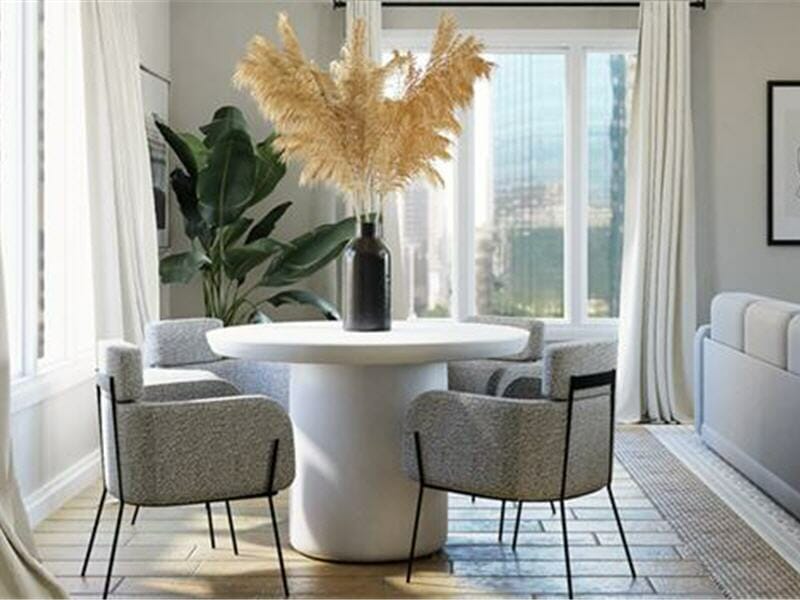
7 Actionable Tips on How to Furnish Rental Apartments
An attractive interior can make a big difference in whether potential customers choose your property over others. Today, we share our top tips on how to furnish rental apartments.
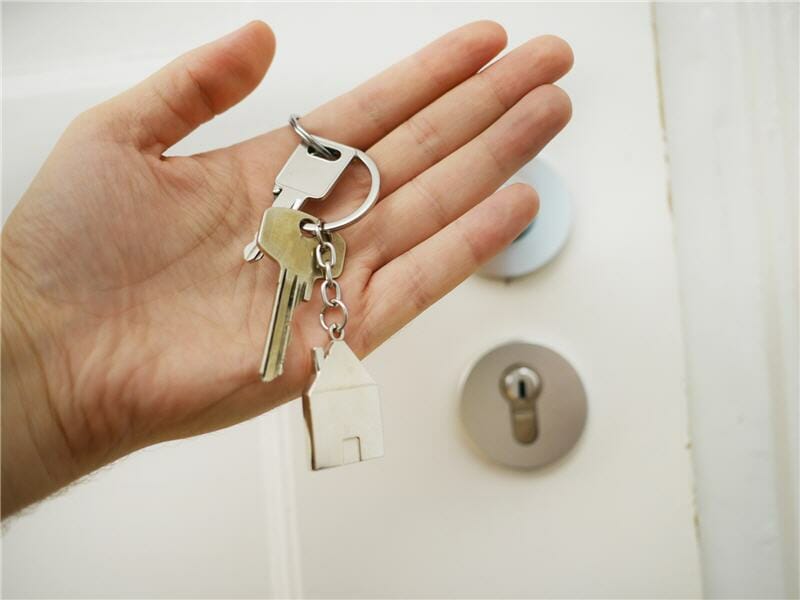
Top Tips When Selling A Property
Whether you’re selling in a city or a cozy suburb, here is a list of 8 elements critical to improving your property sale success rate.
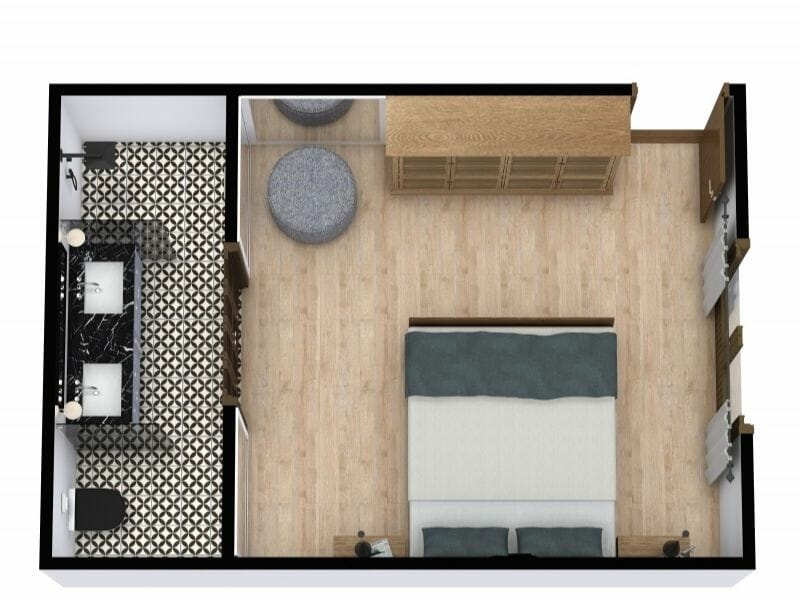
9 Tips to Consider When Planning Your Bedroom Layout
Designing the best bedroom layout can be a bit of a puzzle and a bunch of fun if you know the right questions to ask.
